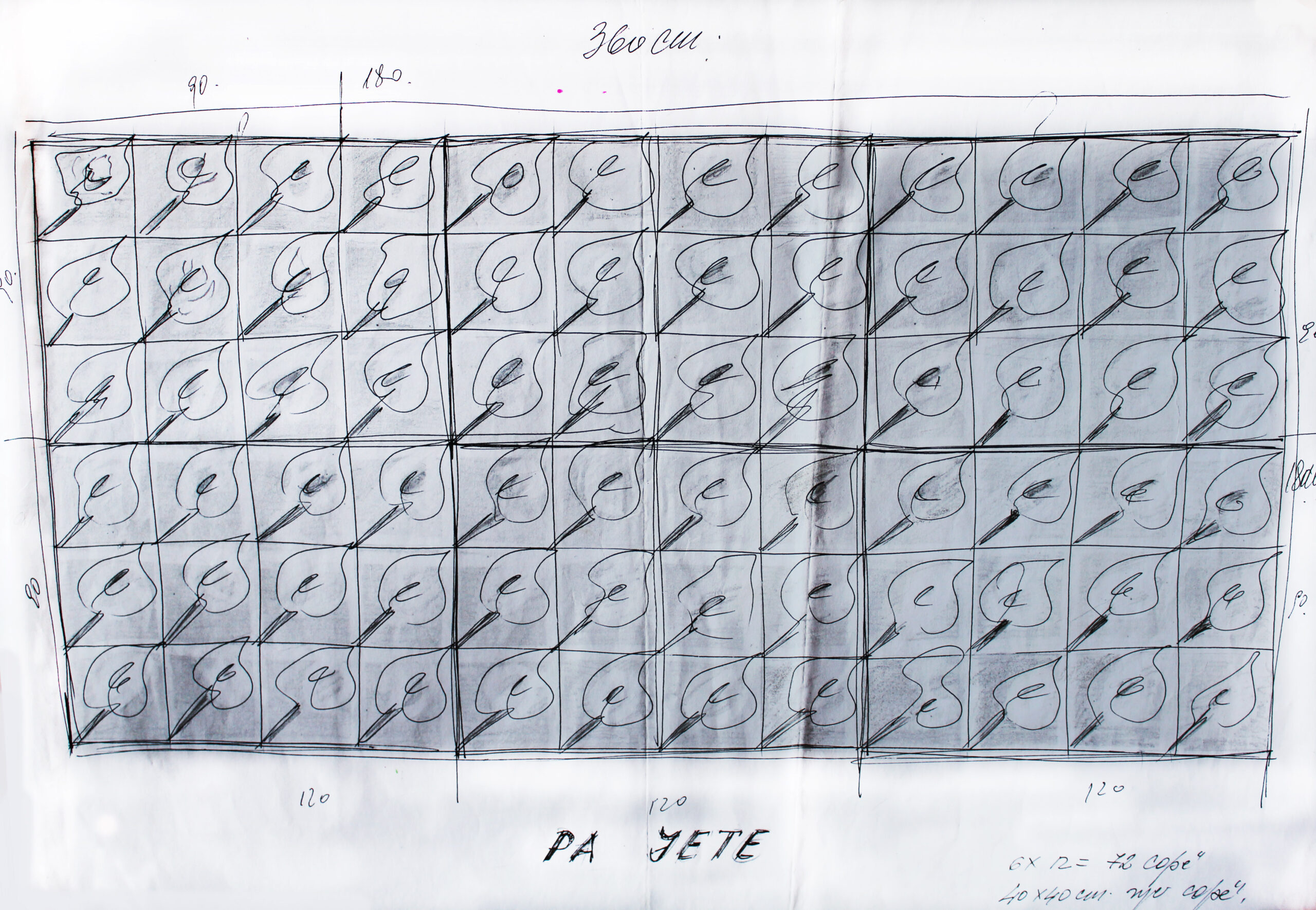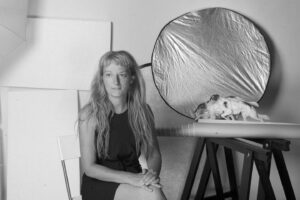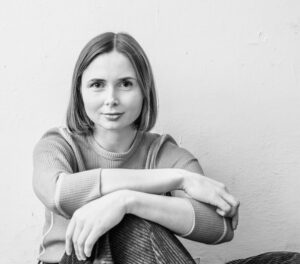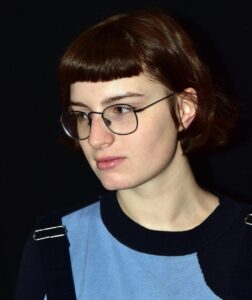Diana Miziri
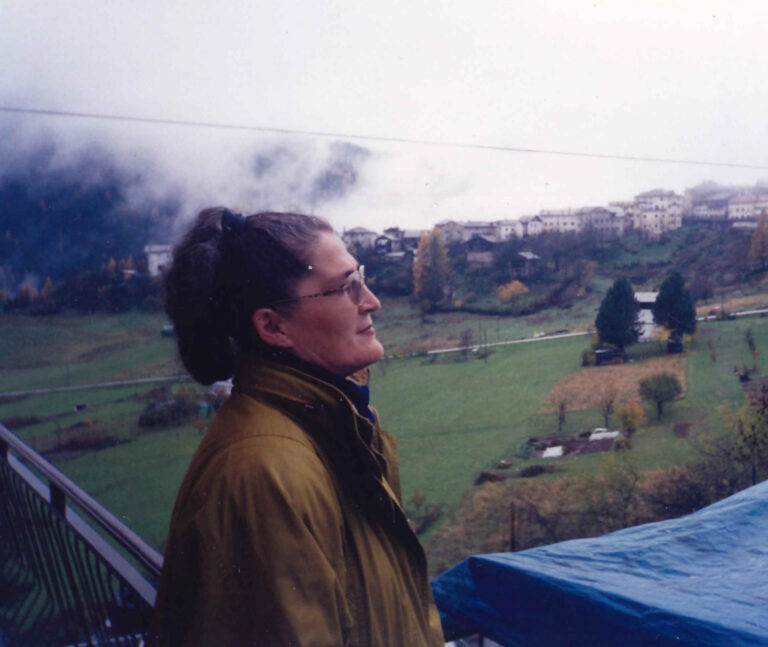
– born in 1951 in Durrës – passed away 2005. She worked mainly with the medium of Textile, Painting, Drawing and Installation. Graduated from the Painting Department at the Higher Institute of Arts in Tirana in 1972. During her studies, she specialized in textile. From 1998–2005, she worked as an art teacher at the Jordan Misja Art High School in Tirana.
Diana’s wish to follow the path of art was personal, this was acknowledged and supported by her family. Back in her early childhood and youth, she got involved in art drawing courses (as they were known before) in her birth town, Durrës. Subsequently, she followed on to higher studies at the Academy of Arts, Textile Design branch, where she graduated in the academic year 1972-1973. Textile design was a branch of the arts that was not her personal choice, however, it was embraced by her nonetheless1. This branch, to which the artist would commit herself so much, would become the main medium of her practice.
Following the completion of Diana’s studies at the Academy of Arts, now known as the University of Arts, she worked at the design bureau of the Carpet Factory in Kavajë, as a designer of the rug models, mainly destined for export. In 1973 she was transferred to Tirana, where she was appointed as a teacher in the subject of artistic drawing at the ‘Mihal Grameno’ school and at the ‘Visual Arts Teaching Course’ at the Palace of Pioneers also. In both positions, she made her contributions, by way of training and encouraging generations of pupils towards the path of visual arts. Following a not very productive period of creative practice, due to the absence of an atelier premises, she was awarded the ‘Leave for creative practice’ for a couple of years and thus she was able to create some work, mainly oil on canvas. Most of these works have been donated and there is no precise documentation of them, apart from a portrait of her son.
She was closely connected to art and she considered it to be part of her identity, while her teaching activity was considered by her as a profession. To her, artistic creativity was an indispensable part and form of expression of thoughts and feelings, much more so during the difficult years of communism, as such a thing was not so easy. Even subsequently, following the change of political systems, times remained troubled and to her art was a meaningful and simultaneously liberating activity. With the emergence of democracy, artists finally found their FREEDOM, thus liberating themselves from the visual dogma imposed by Socialist Realism. The artist brought an intuitive approach2 into the focus of her practice, thus initially deserting the classical forms of composition, as well as technical level implementation. Subsequent to the 1990s her art tended towards improvisation, as she conceived that some moments were more inspiring compared to others, and consequently, she did not generally transfer her ideas into sketches, croquis, bocete etc. As a result of her spontaneity, she had fruitful creative periods, as well as others which were less so.
The transitional changes in the 90s brought about a new development in her creative practice, which was reflected also in her works. She goes back to textile, this time with a new perception of composition, whereby the distinctive trait from the perspective of conception being the creative tendency towards free geometrical3 and more organic abstraction4.
Referring to her technique, the creations of this period have been produced with poor organic materials, and very often previously used (mainly wrapping materials) or had been in industry use from prior to the 1990s. Taking into account that in the course of the transition years there were significant shortages of materials and means for producing the works in textile, the artist tended to use spare materials from the textile industry, remnants of the communist period, and also combining them with materials leftover from import products, such as coffee, rice sacks5, various cotton, wool, linen threads6, etc. A part of these materials were coloured manually to reach the necessary tonality7. Consequently, many of her works were characterised through a recycling and re-utilising approach. The artist has in many instances produced crochet work with cotton threads/fibres, being inspired by popular traditional techniques, thus using them in producing images permeated by a modern and contemporary spirit. These techniques provide a new added value in her creation activity.
Her ideas and composed works in textile were casual, sensual and decorative creations, which did not draw on concrete topics. The composition of her work was closely connected to the materials being used, and as such the sensitivity that the material was providing and the interaction among the materials had a decisive impact on the final work8.
Being a house-wife and mother have been a factor for f her creative practice going through less active periods. However, she always found the time to create. Her family members recall her working everyday, even on small things. Most of her works have been produced within the perimeter of the home , which was adjusted to function also as a studio, and where all the family members were involved in various processes for the production of the necessary materials for the textile: such as producing the wool threads, unweaving of sacks, colouring them, preparing the support structure for the embroidery, etc. A further innovation was the use of random materials, found casually, which she creatively adjusted and transformed according to the need of the piece. Every single textile work was produced without the avail of any machinery or loom, but she adjusted auxiliary structures (like griddles) whereby she fixed the pieces she weaved. Weaving occurred mainly using big needles, up 15 cm long, which were produced by herself, with the assistance of her husband, mainly for wool threads. Some of her works produced in textile, have a co-authorship including her husband, Fatmir Miziri, who is also an artist.
Around 1995, the creative practice was resumed in the studio. She started to try new techniques during the recent years, thus producing works in installation, whereby it is worthwhile mentioning the intertwining of the textile with the technique of the adhesive on glass9 or the production of silhouettes on film negatives10, which were to be projected on the wall. She experimented even with small metal structures being intertwined with the textile, which remained incomplete and un-exhibited. She has left some sketches11 of projects she wanted to realise.
She has been a member of the association of women artists ‘Linda’ and she has participated in many of the exhibitions organised by this group. During 1984-2001 she participated continuously at national exhibitions of Textile, at Onufri competition and at international exhibitions of textile in Switzerland, Italy, France and Germany.
From 1998 she taught the subject of drawing and painting at the Artistic Lyceum ‘Jordan Misja’ until she passed away in 2005.
Statement written by the daughter of the artist, Ela Miziri in collaboration with Adela Demetja (2022).
1Image: Diana Miziri in front of the work for her graduation around 1972. Courtesy of the artist's family.2Image: Diana Miziri, Untitled, 1992, Textile, knitting wool and synthetic thread in a sack support, 90x120cm. Courtesy of the artist's family.
3Image: Diana Miziri, Composition, 1996, Knitting with acrylic threads on a rug, 225 x 160 cm. Courtesy of the artist's family.
4Image: Diana Miziri, Composition, 1991, Textile, knitting wool thread in a sack support, 150x200cm. Courtesy of the artist's family.
5Image: Diana Miziri, Composition, 1992, Textile, knitting wool and synthetic thread in a sack support, 100x130cm. Courtesy of the artist's family.
6Image: Diana Miziri, Composition, 1993, Knitting wool thread in a sack support, 90x120cm. Courtesy of the artist's family.
7Image: Diana Miziri, Composition, 1994, Textile, knitting with acrylic thread on sack support, 100x130 cm. Courtesy of the artist's family.
8Image: Diana Miziri, Composition, 1995, Textile, knitting wool thread in a sack support, 120x90cm. Courtesy of the artist's family.
9Image: Diana Miziri, Composition, 1994, Textile, knitting with textile industry waste on a metallic structure, 180x250 cm. Courtesy of the artist's family.
10Image: Diana Miziri, Botticelli's "Birth of Venus", 2003, Installation, adhesive on glass hanged vertically on a frame that seems to be a unsupported straw rug. Courtesy of the artist's family.
11Image: Diana Miziri, Lifeless, 2002, Sketch for an installation to be realised with artificial lily flowers, 21x29cm. Courtesy of the artist's family.
– lindi 1951 në Durrës – ndërroi jetë në 2005. Punonte me mediumet e tekstilit, pikturës, vizatimit dhe instalacionit. Kreu studimet në vitin 1973, në Universitetin e Arteve, ku diplomoi për pikturë në specialitetin e tekstilit. Nga viti 1998 deri 2005, ajo punoi si mësimdhënëse e artit në Liceun Artistik Jordan Misja në Tiranë.
Dëshira e Dianës për të ndjekur rrugën e artit ishte personale por e pranuar dhe e mbështetur nga familja. Gjatë fëmijërisë dhe rinisë së hershme mori pjesë në rrethet e vizatimit, siç quheshin në atë kohë, në qytetin e saj të lindjes, Durrës. Më pas ajo vazhdoi studimet e larta në Akademinë e Arteve, në degën Tekstil ku dhe u diplomua në vitin 1972-1973. Sipas rregullave të kohës, tekstili ishte një degë që ju paracaktua por që edhe u mirëprit prej saj1. Kësaj dege së cilës artistja do t’i përkushtohej aq shumë, do të kthehej në mediumin kryesor të praktikës së saj.
Pas mbarimit të studimeve në Akademinë e Arteve, sot Universiteti i Arteve, punoi tek byroja e projektimit pranë Fabrikës së Sixhadeve, Kavajë si dizenjatore e modeleve të qilimave, kryesisht për eksport. Në vitin 1973 transferohet në Tiranë ku caktohet mësuese vizatimi pranë shkollës “Mihal Grameno” dhe tek “Rrethi i Arteve Figurative” pranë Pallatit të Pionerëve. Në të dy rastet ka dhënë kontributin e saj duke përgatitur dhe nxitur breza nxënësish drejt rrugës së artit pamor. Pas një periudhe krijimtarie jo shumë të frytshme, në mungesë të një ambienti atelier, merr për disa vite me radhë “Leje-n krijuese” dhe realizon disa vepra, kryesisht vaj në telajo. Shumica e tyre janë dhuruar dhe nuk ka një dokumentim të saktë, përveç një portreti të djalit të saj.
Ajo ishte tepër e lidhur me artin dhe e quante pjesë të identitetit të saj, ndërsa punën në mësimdhënie e konsideronte si profesion. Krjimtarinë artistike e ka patur pjesë të pandashme dhe formë shprehjeje të mendimeve dhe ndjenjave, sidomos në vitet e vështira të komunizimit, ku kjo gjë nuk ishte e lehtë. Po ashtu edhe më vonë pas ndërrimit të pushteteve, kohët ishin të trazuara dhe për të arti ishte një veprimtari kuptimdhënëse dhe në të njëjtën kohë dhe çliruese. Me ardhjen e demokracisë, artistët gjetën më në fund LIRINË, duke u çliruar nga dogma figurative që impononte Realizmi Socialist. Artistja solli në fokus të praktikës së saj, intuitiven2 dhe largimin nga format klasike të kompozimit në radhë të parë, si dhe implementimin në planin teknik. Arti i saj i pas viteve ‘90 ishte i prirur drejt improvizimit, ku ajo besonte se disa momente ishin më frymëzuese në raport me disa të tjera, dhe për rrjedhojë, përgjithësisht nuk hidhte idetë në skica, kroki, bocete etj. Si pasojë e spontanitetit të saj, pati periudha krijimtarie frutdhënëse si dhe të tjera më pak të tilla.
Ndryshimet e viteve ‘90, sollën dhe një zhvillim të ri në praktikën e saj krijuese që u reflektua edhe tek vepra e saj. I rikthehet tekstilit tashmë me një perceptim të ri kompozicional, ku tipari dallues nga pikëpamja e konceptimit është tendenca krijuese drejt abstraksionit gjeometrik3 të lirë dhe atij më organik4.
Sa i përket teknikës, krijimet e kësaj periudhe janë të krijuara me materiale të varfra organike dhe shpesh herë të përdorura më parë (kryesisht si ambalazhe) ose të mbetura nga industria e para viteve ’90. Duke marrë parasysh që në vitet e tranzicionit në Shqipëri kishte mungesa të mëdha në materiale e mjete për realizimin e veprave në tekstil, artistja u shty të përdorte materiale të mbetura nga industria e tekstilit të periudhës së komunizmit, por edhe t’i përziente ato me materiale që mbeteshin nga produktet e importit, si thasë kafeje, orizi5, fije te ndryshme pambuku, leshi, lini6, etj. Një pjesë e tyre ngjyroseshin manualisht për të arritur koloritin e nevojshëm7. Si rrjedhojë, shumë prej veprave karakterizohen nga një qasje ricikluese dhe ripërdoruese. Në shumë raste artistja ka realizuar thurje me grep me fije/fibra pambuku, frymëzuar nga teknikat tradicionale popullore, duke i përdorur ato në realizimin e imazheve me frymë moderne e bashkëkohore. Këto aplikime mund të përmenden si një vlerë e re e shtuar në veprimtarinë e saj krijuese.
Idetë dhe kompozicionet e saj në tekstil ishin krijime të çastit, ndijore dhe dekorative, të cilat kryesisht nuk ndiqnin tematika konkrete. Kompozimi i veprave lidhej ngushtë me materialet e përdorura, dhe si e tillë ndjesitë që i jepte materiali dhe loja midis materialeve kishin ndikim vendimtar në veprën përfundimtare8.
Të qënurit familjare dhe nënë, kanë ndikuar që krijimtaria e saj të kishte periudha më pak aktive. Megjithatë, ajo gjithnjë e gjente kohën për të krijuar. Familjarët e saj e kujtojnë atë çdo ditë duke punuar, qoftë edhe diçka të vogël. Shumica e veprave të saj janë realizuar në ambientin e shtëpisë, i përshtatur si studio, ku të gjithë pjesëtarët e familjes përfshiheshin në procese të ndryshme për prodhimin e materialeve të nevojshme për tekstil: si krijimi i fijeve prej leshi, çtjerrja e thasëve, ngjyrosja e tyre, struktura mbështetëse për të qëndisur etj. Inovacion ishte përdorimi i materialeve të çfarëdoshme, të gjendura edhe rastësisht, të cilat ajo me kreativitet i përshtaste dhe i transformonte sipas nevojës. Çdo punim i saj në tekstil realizohej pa ndihmën e asnjë lloj makinerie, tezgjah, por kishte përshtatur struktura ndihmëse (tip gjergjefi) tek të cilat mbante copat të cilat i thurte. Thurja kryesisht bëhej me gjilpëra të mëdha, deri në 15 cm të gjata, të krijuara nga vetë ajo dhe me ndihmën e bashkëshortit, kryesisht me fije leshi. Disa prej krijimeve në tekstil, të realizuara kanë si bashkëautorësi dhe bashkëshortin e saj, Fatmir Miziri, i cili gjithashtu është artist.
Rreth vitit 1995 puna krijuese vijoi në studio. Në këto vite të fundit filloi te eksperimentonte me teknika te tjera, duke krijuar vepra në instalacion, ku vlen të përmendet ndërthurja e tekstilit me teknikën e adezivit në xham9 apo krijimi i siluetave në negativ filmi10, të cilat do të projektoheshin në mur. Eksperimentoi edhe me struktura të vogla metalike të ndërthurura me tekstilin, të cilat mbetën të papërfunduara dhe të paekspozuara11.
Ka qenë pjesë e shoqatës së artisteve gra “Lindart” dhe ka marrë pjesë në shumë prej ekspozitave të organizuara prej saj. Gjatë viteve 1984-2001 mori pjesë rregullisht në ekspozita kombëtare të Tekstilit, në konkursin Onufri, dhe në ekspozita ndërkombëtare të tekstilit në Zvicër, Itali, Francë e Gjermani.
Nga viti 1998 dha mësim në lëndën e vizatimit dhe pikturës në Liceun Artistik “Jordan Misja” deri sa u nda nga jeta në vitin 2005.
Teksti u shkrua nga vajza e artistes, Ela Miziri në bashkëpunim me Adela Demetja.
1Imazh: Diana Miziri përpara punës së diplomës rreth vitit 1972.2Imazh: Diana Miziri, Pa titull, 1992, Tekstil, fije leshi dhe sintetike në thes, 90x120cm. Kortezi e familjes së artistes.
3Imazh: Diana Miziri, Kompozim, 1996, Thurje me fije akriliku në thes, 225 x 160 cm. Kortezi e familjes së artistes.
4Imazh: Diana Miziri, Kompozim, 1991, Tekstil, thurje me fije leshi në thes, 150x200cm. Kortezi e familjes së artistes.
5Imazh: Diana Miziri, Kompozim, 1992, Tekstil, fije leshi dhe sintetike në thes, 100x130cm, Kortezi e familjes së artistes.
6Imazh: Diana Miziri, Kompozim, 1993, thurje me fije leshi në thes, 90x120cm, Kortezi e familjes së artistes.
7Imazh: Diana Miziri, Kompozim, 1994, Tekstil, thurje me fije akriliku në thes, 100x130 cm. Kortezi e familjes së artistes.
8Imazh: Diana Miziri, Kompozim, 1995, Tekstil, thurje me fije leshi në thes, 120x90cm. Kortezi e familjes së artistes.
9Imazh: Diana Miziri, Kompozim, 1994, Tekstil, thurje me mbetje të industrisë së tekstileve në një strukturë metalike, 180x250 cm. Kortezi e familjes së artistes.
10Imazh: Diana Miziri, Botticelli "Lindja e Venusit", 2003, Instalacion, adheziv në panel xhami të varur vertikalisht mbi një kornizë që duket si tapet kashte. Kortezi e familjes së artistes.
11Imazh: Diana Miziri, Të pajetë, 2002, Skicë për një instalacion me lule artificiale, 21x29cm. Kortezi e familjes së artistes.
